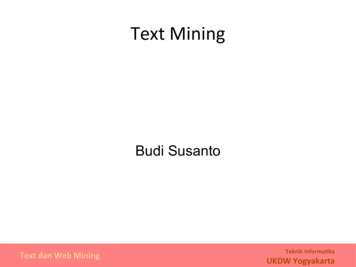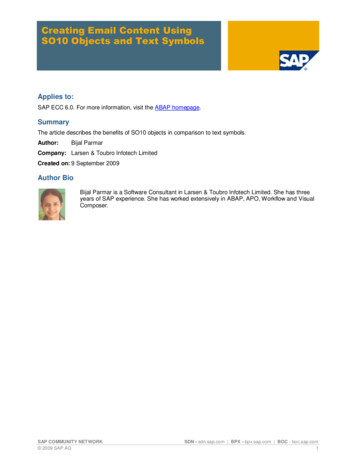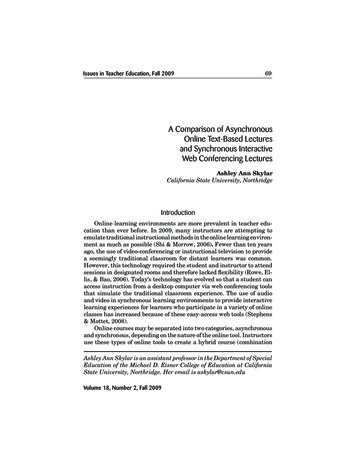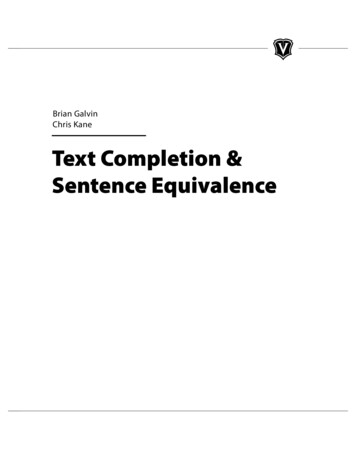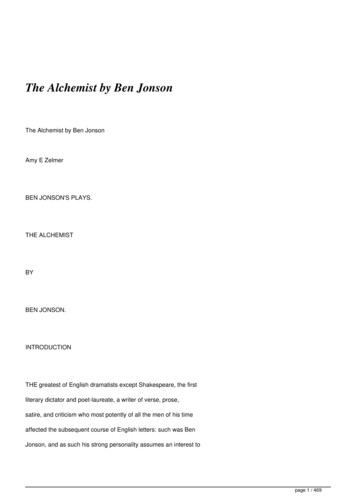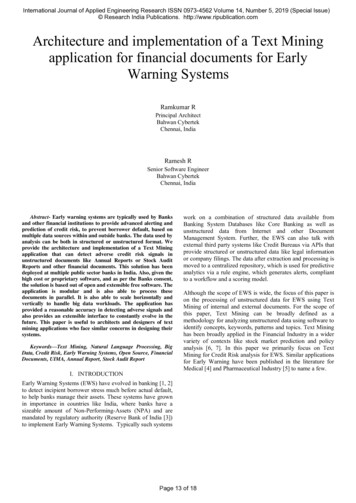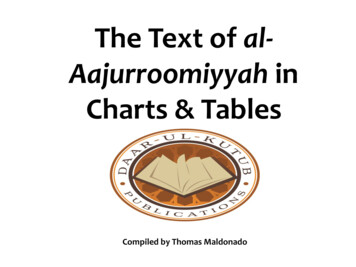
Transcription
The Text of alAajurroomiyyah inCharts & TablesCompiled by Thomas Maldonado
ِ متن اآلج ُّر ِ وميَّة ف اول َو لَ ْو َحات د ج ي ُ ُ ََْ ََ(The Text of al-Aajurroomiyyah in Charts & Tables)Designed and compiled by Thomas MaldonadoCompleted on Friday the 20th of Rabee’ al-Awwal 1429 A.H.corresponding to the 28th of March 2008 C.E.Copyright 2014Permission is granted to all who wish to print this document for public or private use without the consent of the author under the groundsthat such printing is done solely for educational purposes without any desire for personal monetary profit or gains.
Dedication:To all who are striving to learn the language of the Quran and the tongueof the Prophet Muhammad(peace & blessings of Allah be upon him). O’Allah benefit us with what You teach us, teach us what will benefit us, andprovide us with knowledge that will benefit us.
IntroductionIn the name of Allah the Beneficent, the Merciful, all praise is for Allah, Lord of all of the worlds. Peace and blessings beupon our Prophet Muhammad, upon his family, and all of his companions. To begin: The science of an-Nahw (ArabicSyntax) is a noble science indeed. A science of attainment where one attains two very important things, the first is theunderstanding of Allah’s Book and the Sunnah of His Messenger (peace & blessings of Allah be upon him). Indeed many ofthose understand them both or the understanding of many regarding both, are hesitant when it comes to the knowledge ofArabic grammar. The second is to establish the tongue upon the tongue of the Arabs which is the speech of Allah, theMighty &Majestic, or that which has been revealed in the speech of Allah, the Mighty & Majestic, so due to this theunderstanding of an-Nahw (Arabic Syntax) is very important. However an-Nahw (Arabic Syntax) at first is difficult buttowards the end becomes easy. And we will narrate an example of a house fashioned from sugar cane, its door being madeof steel. Meaning it will be difficult to enter but once one has entered it everything after that is easy so due to this it isbefitting for a person to strive upon learning the basics until the rest becomes easy for him. The one who says, “an-Nahw(Arabic Syntax) is too difficult” deserves no attention. Even to the point that the student actually imagines that he cannotmaster it and this is not correct, rather focus on the first part and the rest will become easy. There is one who once said:{Nahw is difficult; its steps are long When one who does not understand it becomes proficient in it He desires to express himself in Arabic only to sound like the ‘Ajamee (the non-Arab).}And this is not correct. We do not agree with this. Rather we say, Allah willing, an-Nahw (Arabic Syntax) is easy, its stepsare short and its levels are easy from the very beginning you will begin to understand it.(ash-Shaykh Muhammad bin Saalih al-‘Uthaymeen in his opening explanation of al-Aajjurromiyyah)
A Brief Biography of Ibn AajurroomHe is Aboo ‘Abdillah Muhammad bin Muhammad bin Daawudas-Sanhaajee, the Faqih (Islamic Jurist), the Nahawee (Arabicgrammarian), Moroccan by birthright, better known as IbnAajurroom which is a word taken from the Berber language ofAmazigh and is alleged to mean “the poor Sufi”.Ibn ‘Anqaa said in al-Kawaakib-ud-Duriyyah (1/25) regarding themeaning of this name: “ it is a non-Arabic word of the Berberssaid to mean the poor Sufi but I did not find the Berbers knowingit to mean that rather it is a specific tribe from amongst theBerbers, a tribe named Banoo Aajurroom.” Ibn Aajurroom’sgrandfather Daawud was the first person to be known by thisnickname.He was born in Fez (Morocco) from an area known as Sanhaajah. He studied there and then desiredto go to Makkah for pilgrimage where he passed through Cairo and stayed there for a while to studyunder and obtain certification from the Andalusian grammarian Aboo Hayyaan Muhammad binYoosuf al-Granaatee (rahimahullah) who passed away in Cairo in the year 745 A.H. (1345 C.E.).While living some time in Makkah he authored al-Muqaddimat-ul-Aajurroomiyyah fee Mabaadee ‘Ilm-il‘Arabiyyah (the Introductory Text of al-Aajuroom regarding the Basic Fundamentals concerning theScience of the Arabic language). It was the primer text that was studied in the science of the Arabiclanguage in his time which based its fundamental sections off of both the Kufi and Basri schools ofgrammar despite the fact that Ibn Aajurroom himself closely followed the school of the Kufis.
After returning from Makkah to Fez he remained teaching Arabic grammar and the Quran in Jaami’-ulHayy al-Andalusee (the Mosque of the Andalusian Quarter) until he died in the year 723 A.H. (1323 C.E.).Ibn Aajurroom was known for giving legal rulings as well as rectifying the peoples affairs and wasdescribed by his contemporaries as being a legal jurist, highly educated, a mathematician, the Imam of anNahw (Arabic grammar and syntax), and the one who had a vast knowledge of other sciences from themTajweed and the recitation of the Quran.He has many other authored works in addition to various poems written in the meter of Rajaz. From themis his explanation of ash-Shaatibee’s (590 A.H./1194 C.E.) poem known as ash-Shaatibiyyah entitledFaraaid-ul-Ma’aanee fee Sharhi Hirzil-Amaatee reaching two volumes. The two volumes that were written byhis hand are stored away in the library of Rabat, Morocco.Ibn-ul-‘Imaan al-Hanbalee (rahimahullah) said of him in Shadhraat-udh-Dhahab: “Aboo ‘AbdillahMuhammad bin Muhammad bin Daawud as-Sanhaajee known as Ibn Aajurroom, pronounced with aFatah on the elongated Hamzah, a Dhammah on the Jeem and a Shaddah on the Raa, the meaning of his namein the language of the Berbers means ‘the poor Sufi’, he is the author of the well known introductorytreatise on Arabic grammar al-Aajurroomiyyah”.And Ibn Maktoom (rahimahullah) made mention of him in his Tadhkarah saying: “An Arabic grammarianand reciter of the Quran, he had a vast knowledge of Islamic inheritance, arithmetic, outstandingmanners, and he authored many beneficial works in addition to various poems written in the meter ofRajaz.”And another said of him: “He was known for grace and piety and what bears witness to this is theprevalence of benefit that is contained in his introductory work al-Aajurroomiyyah.”
ِ م ْتن اآلج ُّر وميَّة فِي َج َد َاول َو لَ ْو َحات ُ ُ َThe Text of al-Aajurroomiyyah inCharts & Tables
ِِِ َّح ِو َم ْت ُن ْاآل ُج ُّروميَّة في اَلن ْ محمد بن محمد بن داود الصنهاجي ، أبو عبداهلل . ولد في فاس سنة 672 هـ وتوفي فيها سنة 723 هـ ال َكالَ ُم األربَـ َعةُ ال ُقيُ ُ ود ْ ظ اللَّ ْف ُ َّ الم ر ب ك َُ ُ ت امل ْشتَ ِّم ُل الص ْو َّ ُ ض ُاحلروفِ َعلَ ِى بَِْع ِ ِ ُُ اهل َجائيَّة الَِِّت َّأوُهلَا األلْف و ِ آخُرَها ُ َ اليَاءُ َما تُرِّكب ِم ْن َكلِمتَ ْ ِ ْي َ َ ُ ْأو أ ْكثَر ِ المف ْي ُد ُ ِ الو ض ِع ب َ ْ اإلسنَ ِاد فَائِ َدة ُُْي ِس ُن بِ ْ ُس ُكوت املتَ َكلِّ ِم َعلَْي َها ِ ث ُالَ ي ِ صْي ُر ِبَْي ُ َ اللس ِام ُع ُمْنتَظًِّرا لِ َشْي ٍئ َّ آخر َ ِ العَربِيَّ ِة أ ْن تَ ُكو ُن بِاللُغَة َ
َ ام ال َكالَِم ثَالَثَة ق ْ سُ أ َ َح ْرف إسم ْ ض َ الخ ْف ُ التَّـ ْن ِويْ ُن الخ ْف ِ ض ُح ُر ُ وف َ فِي ول األلِ ِ ف َو الالَِّم ُد ُخ ُ ب ُر َّ ِم ْن إِلَى البَاءُ َع ْن َعلَى اف ال َك ُ الالَّ ُم س ِم ُح ُر ُ وف ال َق َ الو ُاو َ البَاءُ التَّاءُ فِ ْعل قَ ْد ْي ِّ الس ْ ُ ف َس ْو َ تَاءالتَّأْنِي ِ الساكِنَ ِة ث َّ ُ ْ َما الَ يَ ْ صلُ ُح َم َعهُ دلِ ل ي اإلس ِم َو الَ َُْ ْ دلِيل ِ الف ْع ِل َُْ
اب ا ِإل ْعر ِ اب ب ُ َ َ اخ ِر ال َكلِ ِم ِالختِالَ ِ ف العو ِام ِل الد ِ اب هو تَ ْغيِي ر أَو ِ ا ِإل ْعر ِ َّاخلَ ِة َعلَْي َها لَ ْفظًا أ َْو تَ ْق ِديْ ًرا ْ ُ ْ َ َ ُ َ ََ س ُامهُ ْأربَـ َعة َو أقْ َ َرفْع صب نَ ْ َخ ْفض َج ْزم ِ ِ ِ ِ ِ ِ ِ ِ َّصب ن ال و ع ف الر ك ل ذ ن م ال ع ألف ل و و ب َّص ن ال و ع ف الر ك ل ذ ن م اء ألْس فَل َْ ْ َ َ َّ ْ َ ْ َ َ ْ َ ْ َ َ َّ ْ َ ْ ِ ض فِْي َها ف خ ال و م ز اجل و ا ه ي َ َْ َ َ َ ْ َ اخلَْفض َو الَ َج ْزَم فْ َ
باب م ْع ِرفَ ِة َعالَم ِ ات اإل ْعر ِ اب َ َ ُ َ َ الرفْ ُع َّ الض َّمةُ و الواو و األلِ لِ َّلرفْ ِع أَربع عالَم ٍ ف َو النُّو ُن ات َّ ُ َْ ُ َ َ َ َُ َ ب الن ْ َّص ُ ِ لِ ٍ ف الن ِ َّص ِ ُّون َخ ب ن ل َْ ف َو ال َك ْسَرةُ َواليَاءُ َو َح ْذ ُ س َعالََمات ال َفْت َحةُ َو األل ُ ْ ُ ض ال َخ ْف ُ ِ ث عالَم ٍ ِ خ ل ال ث ض ف ات ال َك ْسَرةُ َو اليَاءُ َو ال َفْت َح ُة ْ َ ل َْ َُ َ َ الج ْزُم َ لِْلجزِ ِ م ع م ال ت ان و ن و ك الس احل ف ذ ْ ُ َ ْ َ ََ َ ُّ ُ َ َ ُ
ِ ِ ٍ َّ ف َو النُّو ُن األل و او الو و ة م الض ات م ال ع ع ب َر أ ع ف لر ل ْ ِ َّ ُ َّ ُ َْ ُ َ َ َ َ َُ َ الرفْ ُع َّ اَِِل ْس ِم اَل ُْم ْف َرِد الض َّمةُ فَتَ ُكو ُن عالَمةً لَ َّلرفْ ِع ِِف أَرب ع ِة مو ِ اض َع ِِف فَأ ََّما َّ َ َْ َ َ َ جم ِع اَلْم َؤنَّ ِ لسالِ ِم ث اَ َّ َْ ُ َج ْم ِع اَلتَّ ْك ِسير َّصل بِ ِ ال ِْف ْع ِل اَلْم َ َّ ِ ِ آخ ِرهِ َش ْيء ُ ضار ِِع اَلذي لَ ْم يَـت ْ وأ ََّما الواو فَتَ ُكو ُن عالََمةً لَ َّلرفْ ِع ِِف َمو ِض َع ِ ْي ِِف َ َُ َ لسالِ ِم َج ْم ِع اَل ُْم َذ َّك ِر اَ َّ س ِة َس َم ِاء اَل َ اَْأل ْ ْخ ْم َ َو ِه َي أَبُو ِ ف فَتَ ُكو ُن عالََمةً لَ َّلرفْ ِع ِِف َوأ ََّما األل ُ أَ ُخو َح ُمو فُو ِ اصة َس َم ِاء َخ َّ تَـثْنِيَة اَْأل ْ َوأ ََّما النُّو ُن فَتَ ُكو ُن عالََمةً لَ َّلرفْ ِع ِِف ِ ص َل بِ ِه اَل ِْف ْع ِل اَل ُْم َ ضار ِِع , إِذَا اتَّ َ ض ِم ُير تَـثْنِيَ ٍة َ ض ِم ُير َج ْم ٍع َ ض ِم ُير اَل ُْم َؤنَّـثَ ِة اَل ُْم َخاطَبَ ِة َ ذُو
لِ ب َخمس َعالَم ٍ ف الن ِ ِ َّص ن ل ُّون ف َو ال َك ْس َرةُ َواليَاءُ َو َح ْذ ُ ات ال َف ْت َحةُ َو األلِ ُ ْ ْ ُ َ ب الن ْ َّص ُ فَأ ََّما الْ َفْتحةُ فَت ُكو ُن ع َالمةً لِ ب ِِف ثََالثَِة مو ِ ِ اض َع َّص ن ل َ َ َ ْ ََ ِْ اِل ْس ِم ال ُْم ْف َرِد َج ْم ِع التَّ ْك ِسي ِر َّصل بِآ ِ ِ ِ ِ ال ِْف ْع ِل ال ُْم َ ِ َخ ِرهِ َش ْيء ضار ِِع إ َذا َد َخ َل َعلَْيه نَاصب َولَ ْم يَـت ْ ِ ِ َّص ِ اخلَ ْم َس ِة َْسَ ِاء ْ ب ِِف ْاأل ْ َوأ ََّما ْاألَل ُ ف : فَتَ ُكو ُن َع َال َمةً للن ْ ك َخ َ ت أَبَ َ اك" َوَما أَ ْشبَهَ ذَلِ َ اك َوأ َ نَ ْح َو َ " : رأَيْ ُ وأ ََّما الْ َكسرةُ : فَت ُكو ُن ع َالمةً لِ َّص ِ ب ِِف ن ل َْ َ َ َ ْ َ جم ِع الْم َؤنَّ ِ السالِ ِم ث َّ َْ ُ وأ ََّما الْيَاء : فَتَ ُكو ُن َع َال َمةً لِلن ِ َّصب ِِف َ ُ ُّون فَي ُكو ُن ع َالمةً لِ وأ ََّما ح ْذ ُ ِ َّص ِ ب ِِف ن ل َ َ ْ ف الن َ َ َ التَّثْنِيَ ِة ْج ْم ِع ال َ ات الن ِ ال الْ َخمس ِة الْتِي رفْـع َها بِثَب ِ ْاألَفْـ َع ِ ُّون َُ َ َْ
ض ال َخ ْف ُ ِ ث َعالَم ٍ ِ ال ث ض ف خ ل ْ ْ َ ات ال َك ْس َرةُ َو اليَاءُ َو ال َف ْت َحةُ ُ َ ل َ َ ض فِي ثََالثَِة مو ِ ْخ ْف ِ اض َع : فِي فَأ ََّما الْ َك ْس َرةُ : فَـتَ ُكو ُن َع َال َمة لِل َ ََ اِلس ِم الْم ْفرِد الْم ْنص ِر ِ ف ِْ ْ ُ َ ُ َ جم ِع التَّ ْك ِسي ِر الْم ْنص ِر ِ ف ُ َ َْ جم ِع الْم َؤنَّ ِ السالِ ِم ث َّ َْ ُ ض فِي ثََالثَِة مو ِ َوأ ََّما الْيَاءُ : فَـتَ ُكو ُن َع َال َمة لِ ْل َخ ْف ِ اض َع : فِي ََ س ِة َس َم ِاء ال َ ْاأل ْ ْخ ْم َ التَّثْنِيَ ِة َوأ ََّما الْ َف ْت َحةُ : فَـتَ ُكو ُن َع َال َمة لِ ْل َخ ْف ِ ض فِي ِ ِْ ف ص ِر ُ اِل ْس ِم الَّذي َِل يَـ ْن َ ْج ْم ِع ال َ
الج ْزُم َ ِ ِ ِ ف ذ الح و ن و ك الس ان ت م ال ع م ز ج ل ْ ْ ُّ ُ ُ َ َ ُ َ ل َ ْ َ ََ الس ُكو ُن فَيَ ُكو ُن َع َال َمةً لِْل َج ْزِم ِِف فَأ ََّما ُّ ِ يح ْاْلَ ِخ ِر الص ِح ِ ضا ِرِع َّ الْف ْع ِل الْ ُم َ ف فَيَ ُكو ُن َع َال َمةً لِْل َج ْزِم ِِف َوأ ََّما ْ احلَ ْذ ُ ِ ضا ِرِع الْ ُم ْعتَ ِّل ْاْلَ ِخ ِر الْف ْع ِل الْ ُم َ اخلمس ِة الِِْت رفْ عها بِثَب ِ ات الن ِ ِ ُّون َ َُ َ ْاألَفْ َعال َْ ْ َ
ات قِسم ِ ان اَل ُْم ْع َربَ ُ ْ َ ات صل اَل ُْم ْع َربَ ُ فَ ْ قِسم يـ ْعرب بِالْحرَك ِ ات ْ ُ َ ُ ََ 1 وقِسم يـعرب بِالْحر ِ وف َ ْ َُْ ُ ُُ 2 احلرَك ِ فَاَلَّ ِذي ي ْعر ِ ات أ َْربَ َعةُ أَنْ َو ٍاع َُُ ب ب ََْ 1 2 3 4 اَِال ْس ُم اَلْ ُم ْفَرُد َجَْع اَلتَّك ِ ْس ِي ُ َّث اَلس ِ اَل َجَْ ُع اَلْ ُم َؤن ِ َّ َّ ِ ِ َّصل بِ ِ ِ آخ ِرهِ الْف ْع ُل اَلْ ُم َ ضا ِرعُ اَلذي ََلْ يَت ْ َش ْيء و الَّ ِذي ي عرب بِاحلر ِ وف أ َْربَ َعةُ أَنْ َو ٍاع َ ُ ْ َ ُ ُُ 1 و ُكلُّها تُرفَع بِالض َّ ِ ب َّمة َو تُْن َ َ َ ُْ صُ ِ ض بِال َك ْسَرةِ َو ُُْتَزُم بِال َفْت َحة َو ُُتْ َف ُ الس ُك ِ ون بِ ُّ التَّثْنِيَةُ 2 السالِ ِم الم َذ َّك ِر َّ َج ْم ُع ُ 1 2 3 ِ ض بِال َفْت َح ِة ص ِر ُ َو ْ ف ُُيْ َف ُ اإلس ُم الَّذي الَ يَْن َ ِ اْلخر ُُيزم ِِب ْذ ِ ف ِ ِ آخ ِرهِ َو الف ْع ُل امل َ ضا ِرعُ املُْعتَ ُّل ُ ْ َ ُ َ ُ ِ ض بِاليَ ِاء ب َو ُُيْ َف ُ الوا ِو َو يُْن َ صُ فَيُ ْرفَ ُع ب َ 3 سةُ ْ األس َماءُ ال َخ ْم َ اء ج َع ْن َذلِ َ َو َخ َر َ ك ثَالَثَةُ أَ ْشيَ َ َّث ِ صب بِال َكسرةِ َجَْ ُع امل َؤن ِ َّ الساَل يُْن َ ُ َْ ُ ِ ِِ ض بِاليَ ِاء ب َو ُُتْ َف ُ فَتُ ْرفَ ُع باأللف َو تُْن َ صُ ِ ض بِاليَ ِاء ب َو ُُتْ َف ُ الوا ِو َو تُْن َ صُ فَتُ ْرفَ ُع ب َ 4 األفْـ َع ُ سةُ ال َ الخ ْم َ وهى يَـ ْف َعالَ ِن ِ ِ ب َو ُُْتَزُم ِِبَ ْذفِ َها فَتُ ْرفَ ُع بالنُّون َوتُْن َ صُ تَـ ْف َعالَ ِن يَـ ْف َعلُو َن تَـ ْف َعلُو َن تَـ ْف َعلِ ْي َن
اب اَْألَفْـ َع ِ ال بَ ُ امل ِ اضي َ 1 ال ثََالثَة اَْألَفْـ َع ُ امل َ ضا ِرعُ ُ 2 األمُر ْ 3 ِ ِ ت" َوُه َو َم ْرفُوع َما َكا َن ِِف أ ََّول ِه إِ ْح َدى اَ َّلزَوائِد اَْأل َْربَ ِع اَلَِِّت َُْي َمعُ َها قَ ْولُ َ ك "أَنَْي ُ أَب ًدا , ح ََّّت ي ْدخل علَي ِه نَ ِ اصب أ َْو َجا ِزم َ َ َ َُ َْ وح اَْْل ِخ ِر أَبَ ًدا َم ْفتُ ُ جمزوم أَبَ ًدا ب ب َ , ويَ ْ ب َ , و ْ ََْن َو َ اض ِر ْ ض ِر ُ ضَر َ ش َرة َ , و ِه َي فالنواصب َع َ إِ َذ ْن أَ ْن لَ ْن َحتَّى اب بِالْ َف ِاء ْج َو ُ ال َ ش َر َو ِه َي ْج َوا ِزُم ثَ َمانِيَةَ َع َ َوال َ لَ ْم َكي َِل ُم َك ْي ْ َِلم اَلْجح ِ ود ُ ُُ ال َْوا ِو أ َْو لَ َّما َّه ِي َو ُّ ا
upon our Prophet Muhammad, upon his family, and all of his companions. To begin: The science of an-Nahw (Arabic Syntax) is a noble science indeed. A science of attainment where one attains two very important things, the first is the understanding of Allah’s Book and the Sunnah of His Messenger (peace & blessings of Allah be upon him). Indeed .




